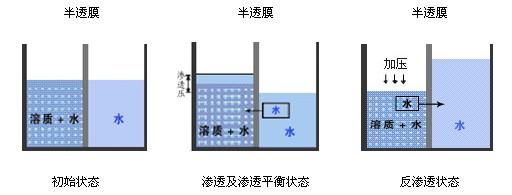l RO (reverse osmosis)
Reverse osmosis (English Reverse Osmosis, abbreviated RO) refers to the process of anti-penetration. Permeation is a natural phenomenon. As shown in Figure 1 , the semi-permeable membrane (the semipermeable membrane only allows water molecules to pass through, other ions are impermeable) separates the water from the salt solution. After a while, the water on the right side It will automatically diffuse to the salt solution on the left side. This phenomenon is called infiltration. When pressurized on one side of the salt solution, reverse osmosis occurs, that is, water diffuses from the salt solution on the left side to the water on the right side, so that pure water can be obtained.

Figure 1 Schematic diagram of reverse osmosis
In practical applications, in order to obtain stable water quality, the reverse osmosis system must be designed according to the water quality, temperature and system operating pressure of the raw water. Common designs include single-stage reverse osmosis and two-stage reverse osmosis. Figures 2 and 3 are schematic diagrams of the process of Rui Sijie single and two-stage reverse osmosis:


Figure 2 Rui Sijie single-stage reverse osmosis process Figure 3 Rui Sijie two-stage reverse osmosis process
As can be seen from the above figure, the two-stage reverse osmosis is superior to the single-stage reverse osmosis in the water quality and recovery rate. Two-stage reverse osmosis is superior to single-stage reverse osmosis in water quality and recovery. Rui Sijie's unique two-stage reverse osmosis process has significant advantages such as high recovery rate, high salt rejection, high adaptability, high stability and extremely low operating cost. It has been created to cope with 1700 μs /cm brackish water. <5 μ s/cm water quality and > 30% recovery (no dosing, no degassing) records.
Nucleic Acid (DNA/RNA) Extraction Kit
1. Introduction
The total viral nucleic acid extraction kit is suitable for extracting total viral nucleic acid from serum, plasma, tissue homogenate and other samples. The kit is based on silica column purification technology, which eliminates the need for toxic phenol-chloroform extraction and time-consuming alcohol precipitation. This product has successfully extracted nucleic acids from hepatitis B A/C, hepatitis C, and norovirus standard. The obtained DNA/RNA can be directly used in a series of downstream experiments such as PCR, RT-PCR, and LAMP.
Notice:
1. The carrier RNA solid must be dissolved in Nuclease Free Water to 1µg/µl before use, and vortex to dissolve. Store in aliquots at -70°C. If you need to store it at -20℃ for a long time, please repackage it according to the number of times of use.
2. Dissolve Proteinase K (20mg/ml): Add Proteinase Dissolve Buffer to dissolve Proteinase K to a final concentration of 20mg/ml. Proteinase K dry powder can be stored at 2-8°C for one year, but dissolved Proteinase K must be stored in aliquots at -20°C. Repeated freezing and thawing of Proteinase K can affect its activity.
3. Buffer VHB must be diluted with 14 ml absolute ethanol before use and stored at room temperature.
4. Buffer RW2 must be diluted with 80 ml of absolute ethanol before use and stored at room temperature.
3. Shelf life
Except for Proteinase K and Carrier RNA, other components of this product can be stored at room temperature (15-25°C) for 12 months, and should be stored at 2-8°C for long-term storage. Proteinase K and Carrier RNA dry powder are transported at room temperature. Please store at -20°C after receiving the test product, and store at -20°C after dissolving.
Nucleic Acid Extraction Reagent Kit,Nucleic Acid Extraction Kit,Covid-19 Nucleic Acid Extraction Reagents,Nucleic Acid Test Kits
Jilin Sinoscience Technology Co. LTD , https://www.jlgkscience.com